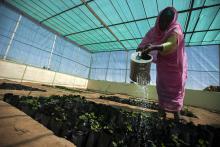Land Library Search
Through our robust search engine, you can search for any item of the over 73,000 highly curated resources in the Land Library.
If you would like to find an overview of what is possible, feel free to peruse the Search Guide.
/ library resources
Showing items 1 through 9 of 479.Countries face severe local and global climate risks with grave social, economic, and environmental costs.
This study addresses the significant issue of land fragmentation in Ethiopia, which is characterized by small, irregular, scattered parcels with no or adequate road access.
This study focuses on land fragmentation in Ethiopia, exploring its impact on agricultural productivity and rural development. It proposes strategies for addressing fragmentation through land consolidation.
Since the global crises in the 2000s, many foreign and domestic actors have acquired large tracts of land for food and biofuel crop cultivation and other purposes in Africa, often leading to the displacement of the African people living on customary land.
Both human activities and climate change have changed landscapes significantly, especially in coastal areas. Sea level rise and land subsidence foster tidal floods and permanent inundations, thus changing and limiting land use.
Context and backgroundIn 2017 Mali developed a law recognizing the customary land rights of local populations called the "Loi sur le Foncier Agricole" (LFA, Farmland Land Law).
Background and Context :Land is a key element for the practice of economic activities such as agriculture. In rural areas, its equitable access is an essential condition for sustainable development and the improvement of the living conditions of populations.
The aim of this study was to examine the challenges of the policies and regulatory framework and strategies for the sustainable mangrove management in Zanzibar, from 1890 to present. The study collected both primary and secondary data.
The pervasiveness of territorial marks in postconflict neighbourhoods elicited this study Relying on residents perceptions the study explored the dynamics underpinning residents use of territorial marks Primary data was collected by administering questionnaires to residents of various neighbourho







